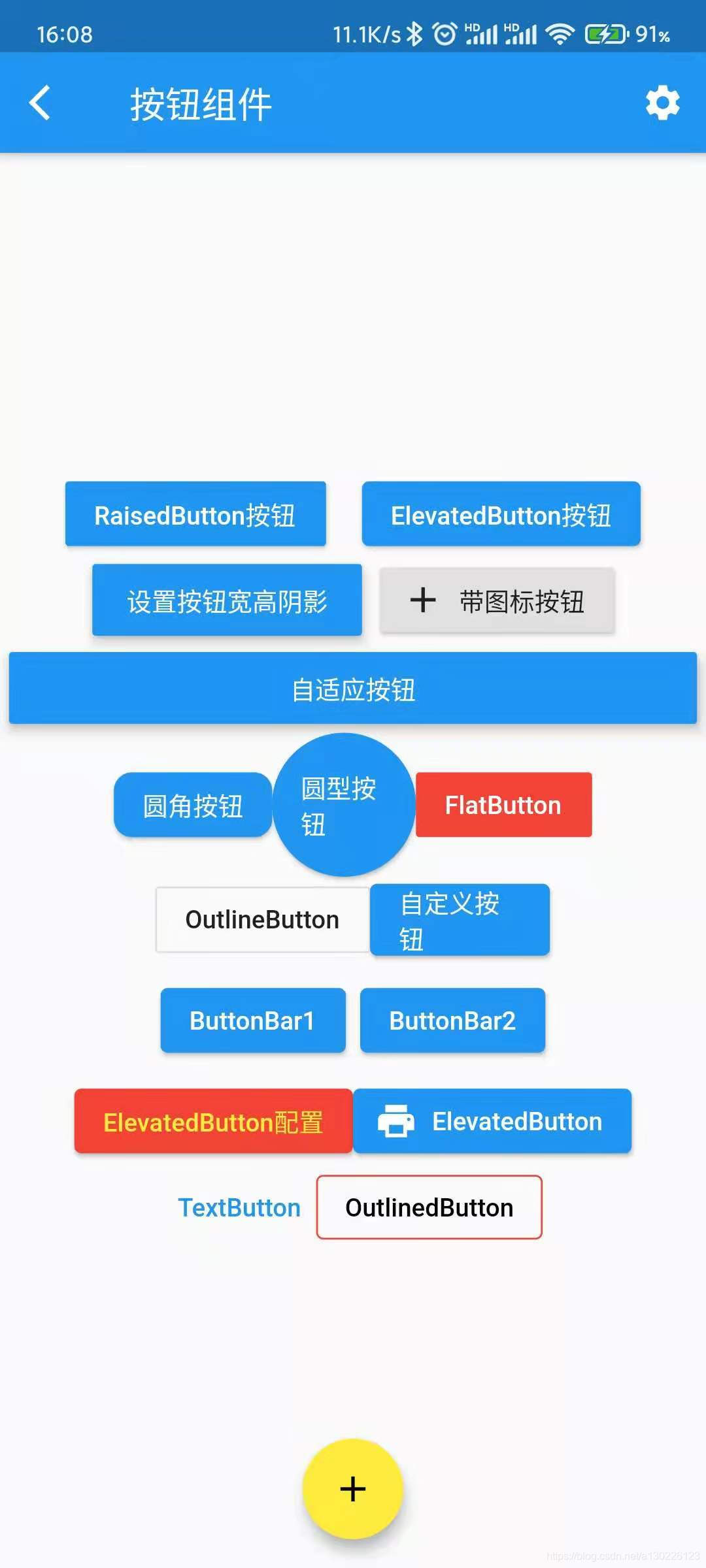flutter学习之基础组件(六)
本次主要学习一些Flutter中的常见的按钮组件以及自定义按钮组件
一、Flutter中的按钮组件介绍
Flutter里有很多的Button 组件很多,参考下表

1.0和2.0的区别就是,1.0的好的属性需要在外部配置,2.0都是放在style里面去配置了
二、各种按钮使用
效果:
相关代码:
import 'package:flutter/cupertino.dart';
import 'package:flutter/material.dart';
import 'package:flutter_view_demo/myProject/main/CurrentTab.dart';
class TestFifteen extends StatefulWidget {
const TestFifteen({Key? key}) : super(key: key);
@override
_TestFifteenState createState() => _TestFifteenState();
}
class _TestFifteenState extends State<TestFifteen> {
@override
Widget build(BuildContext context) {
return Scaffold(
appBar: AppBar(
title: Text("按钮组件"),
leading: Icon(Icons.arrow_back_ios),
actions: [IconButton(onPressed: () {}, icon: Icon(Icons.settings))],
),
floatingActionButton: FloatingActionButton(
onPressed: () {
Navigator.of(context).pushAndRemoveUntil(
new MaterialPageRoute(builder: (context) => new CurrentTab(currentIndex:0)),
(route) => route == null); //所有路由都置为空,在跳转到指定页面
},
child: Icon(Icons.add,color: Colors.black,),
backgroundColor: Colors.yellow,
),
floatingActionButtonLocation: FloatingActionButtonLocation.centerFloat, //设置floatingActionButton位置
body: Column(
mainAxisAlignment: MainAxisAlignment.center,
children: [
Row(
mainAxisAlignment: MainAxisAlignment.center,
children: [
RaisedButton(
onPressed: () {},
color: Colors.blue,
textColor: Colors.white,
child: Text("RaisedButton按钮"),
),
SizedBox(width: 20),
ElevatedButton(
onPressed: () {},
child: Text("ElevatedButton按钮"),
)
],
),
Row(
mainAxisAlignment: MainAxisAlignment.center,
children: [
Container(
width: 150,
height: 40,
child: RaisedButton(
onPressed: () {},
color: Colors.blue,
textColor: Colors.white,
elevation: 5,
child: Text("设置按钮宽高阴影"),
),
),
SizedBox(
width: 10,
),
RaisedButton.icon(
onPressed: () {},
icon: Icon(Icons.add),
label: Text("带图标按钮")),
],
),
Row(
mainAxisAlignment: MainAxisAlignment.center,
children: [
Expanded(
child: Container(
margin: EdgeInsets.all(5),
height: 40,
child: RaisedButton(
onPressed: () {},
color: Colors.blue,
textColor: Colors.white,
elevation: 5,
child: Text("自适应按钮"),
),
)),
],
),
Row(
mainAxisAlignment: MainAxisAlignment.center,
children: [
RaisedButton(
onPressed: () {},
color: Colors.blue,
textColor: Colors.white,
shape: RoundedRectangleBorder(
borderRadius: BorderRadius.circular(10)),
child: Text("圆角按钮"),
),
Container(
width: 80,
height: 80,
child: RaisedButton(
onPressed: () {},
color: Colors.blue,
textColor: Colors.white,
splashColor: Colors.red,
//长按水波纹颜色
shape: CircleBorder(side: BorderSide(color: Colors.blue)),
child: Text("圆型按钮"),
),
),
FlatButton(
onPressed: () {},
child: Text("FlatButton"),
color: Colors.red,
textColor: Colors.white,
)
],
),
Row(
mainAxisAlignment: MainAxisAlignment.center,
children: [
OutlineButton(onPressed: () {}, child: Text("OutlineButton")),
MyBotton(
width: 100.0,
height: 40.0,
pressed: () {},
text: "自定义按钮",
)
],
),
Row(
mainAxisAlignment: MainAxisAlignment.center,
children: [
ButtonBar(
children: [
ElevatedButton(
onPressed: () {},
child: Text("ButtonBar1"),
),
ElevatedButton(
onPressed: () {},
child: Text("ButtonBar2"),
)
],
)
],
),
Row(
mainAxisAlignment: MainAxisAlignment.center,
children: [
ElevatedButton(
onPressed: () {},
child: Text("ElevatedButton配置"),
style: ButtonStyle(
backgroundColor: MaterialStateProperty.all(Colors.red),
foregroundColor: MaterialStateProperty.all(Colors.yellow),
),
),
ElevatedButton.icon(
onPressed: () {},
icon: Icon(Icons.print),
label: Text("ElevatedButton"))
],
),
Row(
mainAxisAlignment: MainAxisAlignment.center,
children: [
TextButton(onPressed: () {}, child: Text("TextButton")),
OutlinedButton(
onPressed: () {},
child: Text("OutlinedButton"),
style: ButtonStyle(
foregroundColor: MaterialStateProperty.all(Colors.black),
side: MaterialStateProperty.all(
BorderSide(color: Colors.red, width: 1))),
),
],
),
],
),
);
}
}
//自定义按钮组件
class MyBotton extends StatelessWidget {
final width;
final height;
final pressed;
final text;
const MyBotton(
{this.width = 80.0,
this.height = 30.0,
this.pressed = null,
this.text = ""})
: super();
@override
Widget build(BuildContext context) {
return Container(
width: this.width,
height: this.height,
child: ElevatedButton(
onPressed: this.pressed,
child: Text(this.text),
),
);
}
}
三、FloatingActionButton实现底部中间bottomNavigationBar
效果图:

在Scaffold中创建floatingActionButton,并且设置floatingActionButton的位置,调整盖到中间bottomNavigationBar的item的图标,在设置点击floatingActionButton的时候,调用刷新页面属性
class _CurrentTabState extends State<CurrentTab> {
int _currentIndex = 0;
_CurrentTabState(currentIndex){
this._currentIndex = currentIndex;
}
List<Widget> _pageList = [
HomePage(),
AddPage(),
MyPage()
];
@override
Widget build(BuildContext context) {
return Scaffold(
// appBar: AppBar(
// title: Text("flutter学习"),
// ),
floatingActionButton: Container(
// margin: EdgeInsets.only(top: 10), //修改上边距
height: 70,
width: 70,
padding: EdgeInsets.all(8),
decoration: BoxDecoration(
borderRadius: BorderRadius.circular(40),
color: Colors.white
),
child: FloatingActionButton(
onPressed: () {
setState(() {
this._currentIndex = 1;
});
},
child: Icon(Icons.add,color: this._currentIndex == 1 ? Colors.white:Colors.black,size: 28,),
backgroundColor: this._currentIndex == 1 ? Colors.red:Colors.yellow,
),
),
floatingActionButtonLocation: FloatingActionButtonLocation.centerDocked,
body: _pageList[_currentIndex],
bottomNavigationBar: BottomNavigationBar(
currentIndex: _currentIndex,
onTap: (int index){
setState(() {
_currentIndex = index;
});
},
fixedColor: Colors.pinkAccent[100],
type: BottomNavigationBarType.fixed,
items: [
BottomNavigationBarItem(icon: Icon(Icons.home), title: Text("首页")),
BottomNavigationBarItem(icon: Icon(Icons.home), title: Text("添加")),
BottomNavigationBarItem(icon: Icon(Icons.home), title: Text("我的")),
],
),
);
}
}